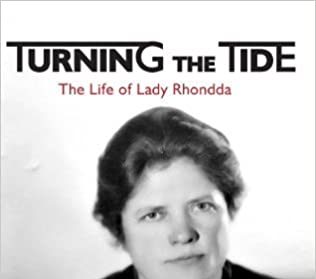Adam Somerset reviews Angela V John’s Turning the Tide: The Life of Lady Rhondda, which recounts the story Welsh Suffragette Margaret Haig Thomas.
The central building on Caerleon’s university campus with its clock tower is now an emblem of continuity and historical weight. It is probably a rare student who glances down to the modest foundation stone to the right of its main doorway. It was laid by Lloyd George’s fellow Liberal and Home Secretary, Reginald McKenna. A century ago McKenna was at the focus of the campaign for female suffrage. On the occasion of McKenna’s ceremonial presence at the then Monmouthshire training college in July 1912 campaigners are present, among them the twenty-nine year old Margaret Haig Thomas.
By the time reports reach London the press is declaring that the Home Secretary has been ‘violently shaken’ by a ‘Woman in Pink’. Margaret Haig Thomas attempts to put the record straight via the pages of the Western Mail. McKenna’s assailant had indeed grabbed his lapel but she was no more than ‘a frail, fragile little person’. Furthermore she had since suffered heart strain as a consequence of ‘the violent way she was caught hold of when hurled down the steps’.
One aspect of the art of the historian is the ability to evoke time and place. Angela V John takes her reader to the heart of the suffragette movement. A train sets off from Cardiff with three hundred and sixty-five women of Wales to join a demonstration in Hyde Park. Anywhere between a quarter and a half million protesters assemble on 21 June 1908, Britain’s largest mass demonstration since the Chartists came together in April 1848.
Nearer to her subject’s Llanwern home the author depicts Margaret Haig Thomas on stage at a meeting in Aberdare. At first she is greeted with bells, whistles and trumpets. Herrings, tomatoes and cabbages are hurled at the platform. Dead mice are thrown, then live mice are let loose, and sulphurated hydrogen gas, snuff and cayenne pepper released into the air.
The smashing of chairs and windows in Aberdare is a mirror of the wider assaults by the suffragette campaigners. The network of fifty thousand post boxes makes a regular target. Attacks with tar, treacle, gum and ink escalate to the use of gunpowder and phials of phosphorus. Haig Thomas encounters the Prime Minister himself while he is on a constituency visit to St Andrews. She jumps onto his car rendering the Premier in her words ‘looking white and frightened and rather like a fascinated rabbit’. The women protesters in turn have their hats knocked off, their clothes torn and are rescued by three young golf caddies.
A prominent historian on a Hay Festival panel in 2012 called for a more balanced view of Wales’ industrial leaders. A facile strand of Welsh theatre, emanating from Flintshire, likes to represent Wales as solely composed of doughty workers and earthy toilers of the land. History is not so simple; industrial tyranny and abuse of oligopolistic power go uncomfortably hand in hand with entrepreneurial flair, technical innovation, philanthropy and social amelioration.
Margaret Haig Thomas’ life, ambitions and accomplishment rested on privilege of birth. Angela V John captures the two-sided contradictions in her father, D A Thomas. With some irony the combative industrialist had ascended to a position of popular acclaim at the time of his sudden death in 1918.
Haig Thomas saw in the two Emancipation Acts, 1918 and 1928, the fulfilment of the campaigning years of the first part of her life. ‘Women have seen what they can do’ she tells a journalist in October 1917 ‘they have learned to undertake the most amazing difficult tasks’. The second half of John’s narrative is given to her career as writer and editor-publisher of the journal Time and Tide.
In 1921 Haig Thomas publishes a three hundred page biography of her father. Time and Tide establishes for itself a circulation of twelve to fifteen thousand, only a thousand or so behind the centuries-old Spectator. It reinforces Margaret Haig Thomas’ position at the centre of literary and cultural life. She is friends with Ellen Wilkinson, Labour’s first woman MP and writer of the 1929 novel Clash. An incident in which her printers refuse to deal with a Sean O’Casey story on grounds of its sexual explicitness brings letters of protest from Yeats, Shaw, Desmond McCarthy and Harold Laski.
Her eminence gives rise to a crude caricature in a 1937 novel by H G Wells. The literary career runs side by side with an array of public and business roles and activities. An AGM of the Celtic Collieries Ltd opens with the address ‘Lady Rhondda and Gentlemen’. She is chair on a platform at a 1927 Trafalgar Square rally that calls for further parliamentary reform. The Equal Franchise Bill receives its Royal Assent 2nd July 1928.
The last pages of this accomplished biography summarise well the life and legacy. Angela V John in Turning the Tide does not play down the privilege of birth but retraces the years of campaigning for equality, actions that take her subject as far as a prison sentence. The by then Lady Rhondda’s full and eventful life ends aged seventy-five July 1958. The Times heads its obituary ‘Champion of her Sex’.
Angela V John and Parthian have done their subject proud. Notes and index run to one hundred pages and testify to the rigour and scholarly quality of approach. Turning the Tide is a very fine political and cultural biography.
Turning the Tide by Angela V. John Parthian Books, £20.00
Adam Somerset is an essayist and a regular contributor to Wales Arts Review.












